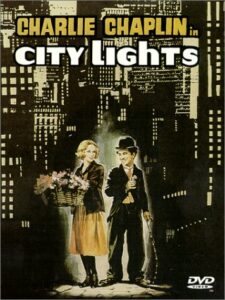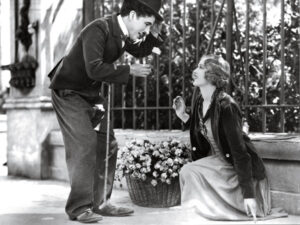“City Lights” – Chaplin’s Tribute to Silent Cinema

Title: “City Lights”
Release Date: 1931
Director: Charlie Chaplin
Cast: Charlie Chaplin, Virginia Cherrill, Harry Myers, Florence Lee, Hank Mann
This film was Charlie Chaplin’s farewell to silent cinema. The director showed in it the full extent of his artistic craftsmanship, creating a beautiful, touching picture that is considered a classic of world cinema.
“City Lights” was made in 1931 in spite of the sound system of the cinema, which had been introduced 4 years earlier. Charlie Chaplin made this film first and foremost to show the beauty of silent cinema, which was becoming a thing of the past. The director created a unique work, captivating with its simplicity and mastery of form. Chaplin used his favorite genre – lyrical comedy with a deep humanistic message.
“City Lights” – Tramp and a blind florist in the big city
“City Lights” is a film with an incisive, almost melodramatic plot. Here, Charlie Tramp, well known to cinema goers, appears in a big American city, where he accidentally meets a beautiful, blind florist (Virginia Cherrill). Of course, he falls in love with the poor girl without a memory and decides to help her.

The Tramp’s fate unexpectedly intertwines with the history of a millionaire (Harry Myers). When he is devastated after his wife leaves him, Charlie tries to commit suicide by drowning in a river. In this way he becomes the rich man’s companion during his nighttime escapades. But the problem is that every morning the same story repeats itself – the man doesn’t remember anything that happened at night, and Trump faces a nasty throw out the door. A friendship with a millionaire, however, helps Charlie pretend to be a millionaire and win the affections of a beautiful florist. When the florist is threatened with eviction for unpaid rent, Charlie is determined to get her money. After a series of hilarious adventures in the boxing ring, he finally gets a millionaire to pay off his debts and perform an eye operation to restore her sight. However, Charlie is arrested and imprisoned on charges of theft. After being released, he unexpectedly meets the girl he loves. The florist recognizes him the moment she touches the Tramp’s hand with a flower.
“City Light” – comedy lyricism and satire
“City Lights” is a movie in which Chaplin, as usual, masterfully combined two aesthetics: lyricism and comedy. The touching story does not prevent the director from showing a whole range of comic gags. The director deliberately limited the dialogue-descriptive parts in favor of eloquent pantomime and situational comedy. “City Lights” was to show the highest art of silent comedy. Chaplin’s favorite tricks – especially his unparalleled use of the body – no longer had a place in sound cinema. All the more reason for “The Gold Rush” director to have perfected all the details.

Chaplin was also tempted in “City Lights” to satirize the nascent sound cinema. The film’s opening scene is a mockery of “talkies,” or dialogue fragments in motion pictures with sound. Instead of a speech on the occasion of the unveiling of the monument, we hear incomprehensible gibberish coming out of the mouths of the representatives of the authorities. The satirical edge of the film also lies in its problematic layer. We are dealing here with a painful unmasking of capitalism as a system that has no room for weaker individuals. What is more, capitalism appears as a reality full of absurdities. A blind girl cannot support herself in spite of her job, while an unproductive millionaire who spends his life having fun spends it in luxury.
In this sense, Charlie Trump with his distinctive clothes and sophisticated elegance remains an icon of the struggle for the dignity of the poor. His character shows that even in the most difficult circumstances, an individual must not be deprived of his right to humanity. It is worth mentioning that audiences appreciated Chaplin’s artistry and the silent film broke popularity records, outclassing its sound rivals.
Literature:
A.Grabicz, J. Klimowski, Kino, wehikuł magiczny. Podróż pierwsza: 1913 – 1949″, Kraków 2007.

